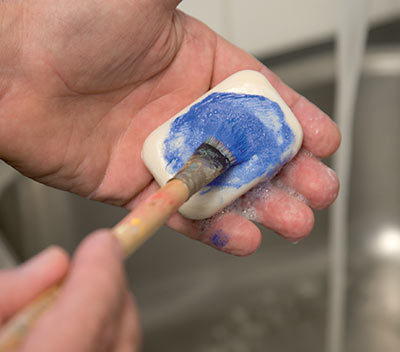Brushes & Painting Knives to use with Cobra
Which brushes can be used for painting with Cobra water mixable oil colours?
The brushes you need for water mixable oil paint depends on the technique applied and your personal preference.
When working with thick paint firmer brushes of hog bristle or synthetic hairs are usually used. In combination with water, hog bristle becomes somewhat softer and consequently less resilient; however, the shorter the hair bundle, the less influence the water has on the result. Hog bristle brushes are not suitable for painting sharp, fine details.
Synthetic brushes (made from polyester fibre) are usually called filament brushes. Their properties are somewhere between that of hog bristle and soft hair types; they are firm enough for applying unthinned paint, but also suitable for working in details and for glazing.
An advantage of filament brushes is that they are not sensitive to water, which thereby helps to retain their resilience. The brush stroke is less robust than that of hog bristle.
For thinned paint, glazing layers and finely painted details it is best to use brushes with softer hair, such as red sable hair and ox hair although the latter is somewhat less suitable for very fine details.
How can brushes be cleaned?
 Brushes can be rinsed during the work in water. By first removing any excess paint with a tissue or a cloth it is avoided that water gets too dirty very quickly.
Brushes can be rinsed during the work in water. By first removing any excess paint with a tissue or a cloth it is avoided that water gets too dirty very quickly.
To keep the brushes in a good condition for a long time, they are best cleaned with a mild soap and water after the work.
Wash the hair bundle several times in the palm of the hand until the foam is completely white and then rinse it with clean water. Do not put too much pressure as the hair can then break on the edge of the ferrule.
Dry the brushes and leave them to dry further with the hair bundle pointing upwards or laying on the table.
What soap can I best use to clean my brushes?
There are many expensive agents to clean brushes, but a mild neutral hand soap, green soap or washing-up liquid also work very well.
Are Cobra water mixable oil colours suitable for working with painting knives?
Cobra water mixable oil colours are ideally suited for working with painting knives. Painting knives are usually used for unthinned paint, often for applying thick dabs of paint (impasto). Use the underside of the knife to mix the paint on the palette, to take the paint off the palette and to apply it onto the canvas. Painting knives are available in various shapes and sizes. Every knife has its own possibilities. A few words of advice:
- Rest the index finger on the raised part of the knife, which will help to keep the fingers clean.
- Take paint off the palette as if you are taking butter for a sandwich.
- Use the entire length of the knife, and not only the point.
- Mix the paint toward you, as this gives you a better feel for what you're doing.










